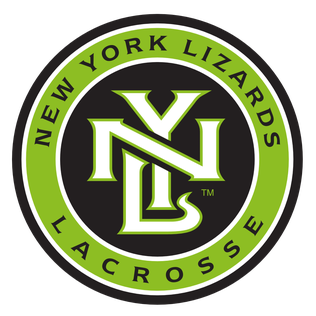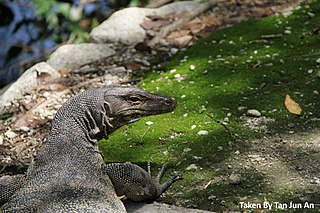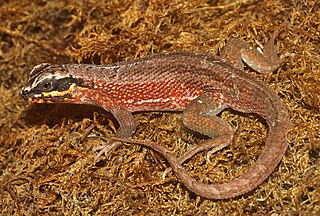
Reptiles are tetrapod animals in the class Reptilia, comprising today's turtles, crocodilians, snakes, amphisbaenians, lizards, tuatara, and their extinct relatives. The study of these traditional reptile orders, historically combined with that of modern amphibians, is called herpetology.

The New York Lizards, originally the Long Island Lizards, are a Major League Lacrosse (MLL) team based in Hempstead, New York, located on Long Island. They are original members of the MLL. They lost the league's inaugural game on June 7, 2001 to the Baltimore Bayhawks, 16–13.

Squamata is the largest order of reptiles, comprising lizards, snakes and amphisbaenians, which are collectively known as squamates or scaled reptiles. With over 10,000 species, it is also the second-largest order of extant (living) vertebrates, after the perciform fish, and roughly equal in number to the Saurischia. Members of the order are distinguished by their skins, which bear horny scales or shields. They also possess movable quadrate bones, making it possible to move the upper jaw relative to the neurocranium. This is particularly visible in snakes, which are able to open their mouths very wide to accommodate comparatively large prey. Squamata is the most variably sized order of reptiles, ranging from the 16 mm (0.63 in) dwarf gecko to the 5.21 m (17.1 ft) green anaconda and the now-extinct mosasaurs, which reached lengths of over 14 m (46 ft).

The Lizard is a fictional character, a superhero appearing in American comic books published by Marvel Comics. The character is usually depicted as Spider-Man. In 2009, The Lizard was ranked IGN's 62nd Greatest Comic of All Time. In the stories, Dr. Connors was a genetic biologist who researched the ability of certain reptiles to regrow missing limbs, partially to find a way to regenerate his right arm. After a test on himself, he transforms into a violent lizard monster. Though able to revert to his human form, he suffers occasional fits of his alter ego breaking free.

Horned lizards (Phrynosoma), also known as horny toads or horntoads, are a genus of North American lizards and the type genus of the family Phrynosomatidae. The common names refer directly to their flattened, rounded body and blunt snout.

The monitor lizards are large lizards in the genus Varanus. They are native to Africa, Asia, and Oceania, but are now found also in the Americas as an invasive species. Currently, 79 species are recognized.

Iguania is an infraorder of squamate reptiles that includes iguanas, chameleons, agamids, and New World lizards like anoles and phrynosomatids. Using morphological features as a guide to evolutionary relationships, the Iguania are believed to form the sister group to the remainder of the Squamata. However, molecular information has placed Iguania well within the Squamata as sister taxa to the Anguimorpha and closely related to snakes. Iguanians are largely arboreal and usually have primitive fleshy, non-prehensile tongues, although the tongue is highly modified in chameleons. The group has a fossil record that extends back to the Early Jurassic.
Leptodactylus ventrimaculatus is a species of frogs in the family Leptodactylidae.

Mantidactylus ventrimaculatus is a species of frog in the family Mantellidae. It is endemic to Madagascar. Its natural habitats are subtropical or tropical moist lowland forests and subtropical or tropical moist montane forests. It is threatened by habitat loss.

The reticulated poison frog, known in French as dendrobate à ventre tacheté, is a species of poison dart frog. It is native to South America, where it can be found in Brazil, southeastern Colombia, Ecuador, French Guiana, and Peru.
Diasporus ventrimaculatus is a species of dink frogs, in the genus Diasporus. It was originally described as Diasporus ventrimaculatus sp. nov. in Zootaxa in 2009.
Petracola is a genus of lizards in the family Gymnophthalmidae. The genus is endemic to Peru.
Lightbulb lizards are found in the following genera:
Petracola angustisoma is a species of lizard in the family Gymnophthalmidae. It is endemic to Peru.
Petracola labioocularis is a species of lizard in the family Gymnophthalmidae. It is endemic to Peru.
Petracola waka is a species of lizard in the family Gymnophthalmidae. It is endemic to Peru.











